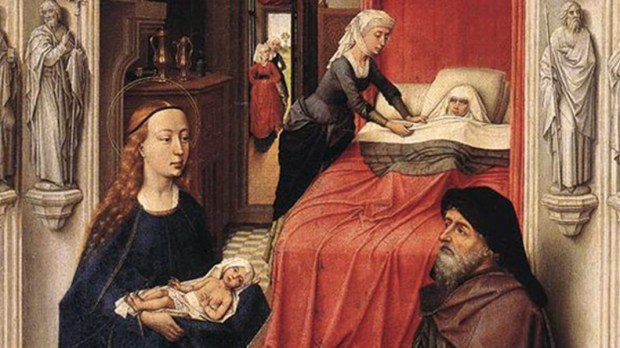It’s been six months since Christmas, and the Church says it’s time for your quarterly reminder of the Baby Jesus. This time it comes in the person of Baby John the Baptist, Jesus’ cousin, whose birth we celebrate June 24.
Easter is so powerful we dedicate each Sunday to the Resurrection, so we’ll never forget the new life Jesus gave us.
But Christmas is powerful too — it is most people’s favorite holiday — and the Church calendar presents us with baby news every three months, so we’ll never forget the magic of Christmas.
First comes the news that Mary is pregnant.
On March 25, as the year’s first quarter ends, we get the feast of the Annunciation and the first announcement of Christmas.
“Behold, you will conceive in your womb and bear a son, and you shall call his name Jesus,” Gabriel tells Mary. “He will reign over the house of Jacob forever; and of his kingdom there will be no end.”
This is the good news distilled: God promises his people that he is coming, and we must prepare to receive our newborn king. The Church remembers that Christmas promise every day in the Angelus.
Three months later, we hear about the birth of Jesus’ cousin, John.
On June 24 as the year’s second quarter ends, we get the birth of John and another Christmas announcement (it was celebrated on June 25 until the calendar was recalibrated).
Zechariah, John’s father, tells the infant, “And you, child, will be called the prophet of the Most High; for you will go before the Lord to prepare his ways.”
For millennia, religious have prayed Zechariah’s words in the Benedictus every morning, turning each dawn into a sign of Christmas.
Three months after that, we get the birth of Mary, who is herself a sign of Christmas.
September 8 is the feast of the Birth of the Virgin Mary, who, along with John and Jesus, is the third and final baby celebrated each year in the Church calendar. The liturgy hails Baby Mary as a signal that Christmas is close.
“Your birth, O Virgin Mother of God, is the new dawn that proclaims joy to the whole world, for from you has been born the sun of justice, Christ our God,” opens the day’s Mass.
Three months after that, on December 8, we get more baby news.
Exactly three months after the Nativity of Mary comes the Feast of the Immaculate Conception.
That day celebrates the conception of Mary without sin from the very beginning — the same reality we remember every time we pray our most common reminder of Christmas: “Hail Mary, full of grace, the Lord is with you. Blessed are you among women and blessed is the fruit of your womb, Jesus.”
All of these feasts orbit around Christmas, the world’s favorite story, and take all their power from it.
The principle joy of Christmas is the story of the life of Christ, and that story commences at the Annunciation, when “The word was made flesh and dwelt among us.”
The second joy of Christmas is the joy of our family drawing close. Baby John the Baptist, Gabriel tells Zechariah, “will turn many of the sons of Israel to the Lord their God,” and will “turn the hearts of the fathers to the children.”
The third joy of Christmas is giving gifts. This is the message of the Nativity of Mary, according to Pope Francis. “Mary knew how to transmit God’s light, and she reflected the rays of that light in her home which she shared with Joseph and Jesus, reflecting it also in her people, her country,” he said.
Mary’s whole life is self-gift.
The fourth joy of Christmas is receiving gifts. Mary’s Magnificat is her song of sheer joy at the many gifts she has received from the time of the Immaculate Conception on: “My soul magnifies the Lord … he who is mighty has done great things for me … he has filled the hungry with good things … He has helped his servant Israel.”
So enjoy today’s “little Christmas.”
We are as far away from Christmas on the calendar as we will be all year, and yet it is as close as ever. God keeps sending us baby news so we will never forget.

Read more:
How following the liturgical calendar can change your life


